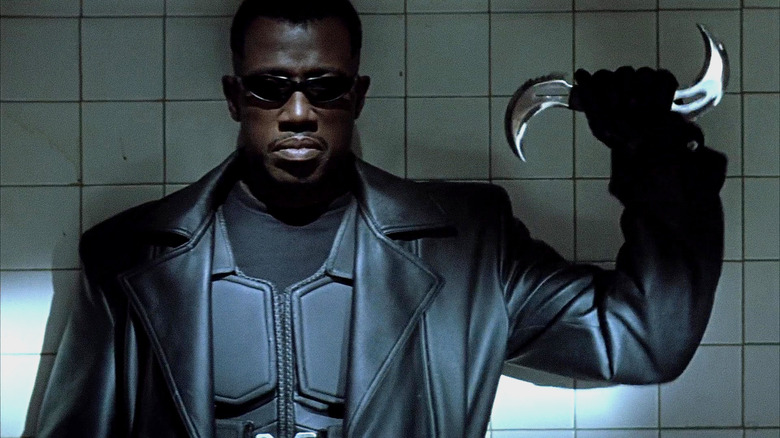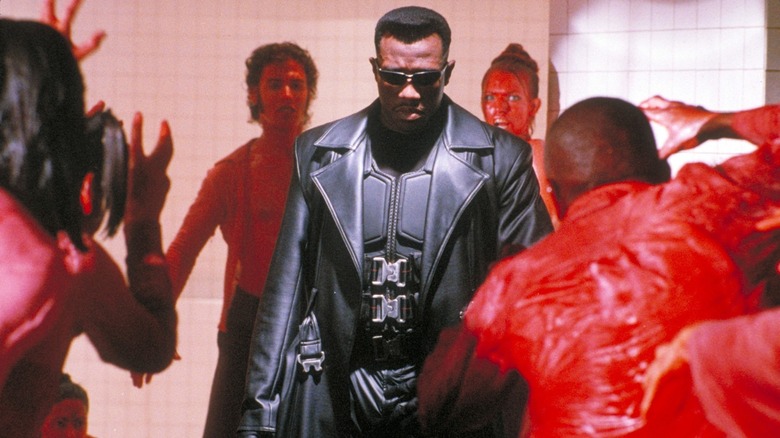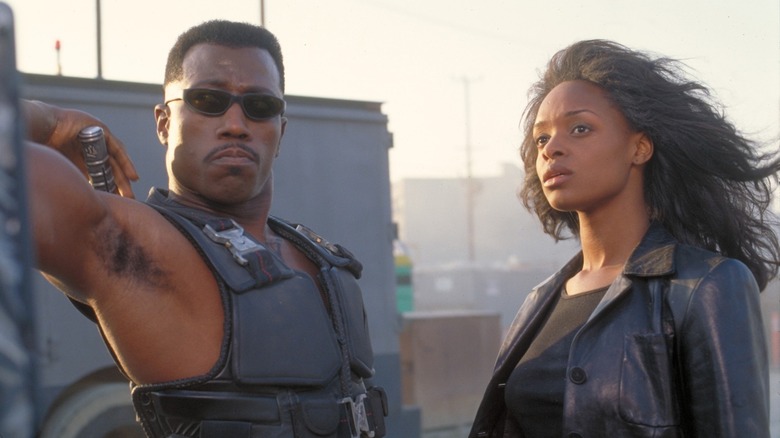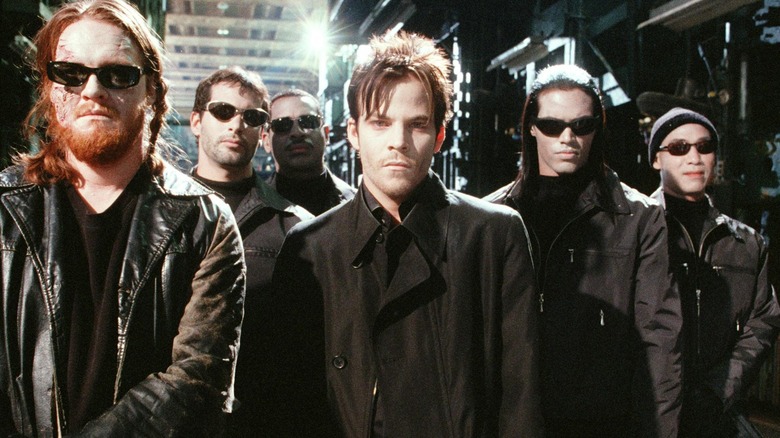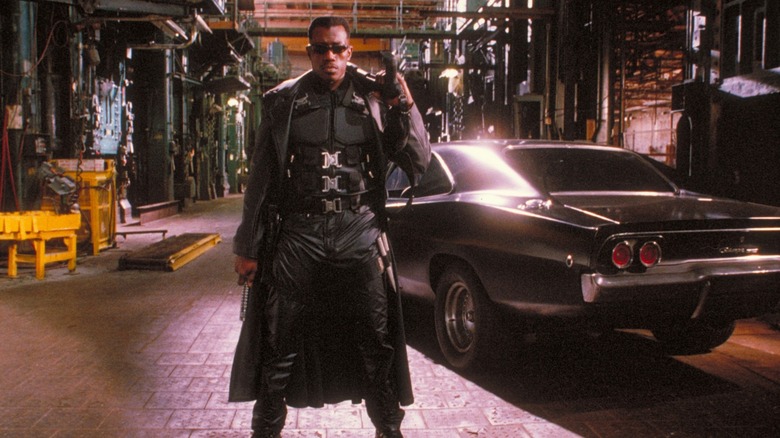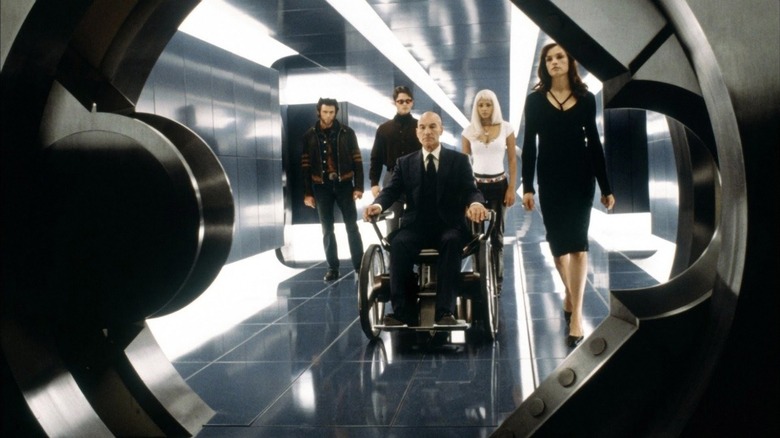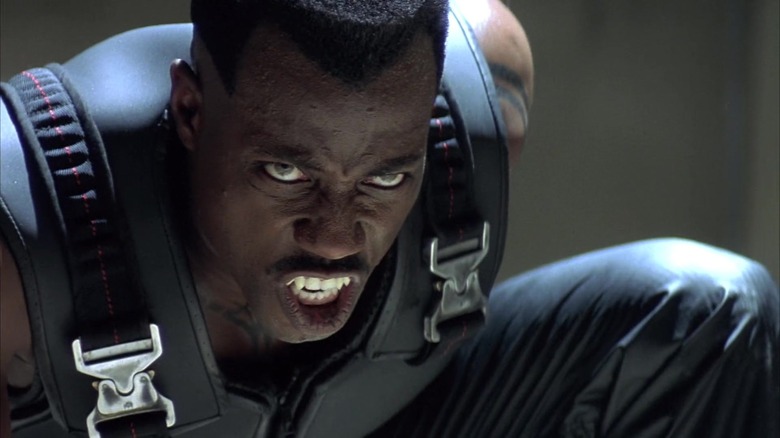Marvel's Blade Was A Modest Box Office Hit — And One Of The Most Important Movies Ever Made
(Welcome to Tales from the Box Office, our column that examines box office miracles, disasters, and everything in between, as well as what we can learn from them.)
Marvel is one of the most recognized and powerful names in all of pop culture. The world over, the name brings to mind enduring heroes such as Spider-Man and Iron Man, with movies based on the publisher's characters generating tens of billions at the box office over the last 20 years and change. But it wasn't always that way. Before Marvel became such a force to be reckoned with, the company was in the middle of an ugly bankruptcy and was on the verge of financial ruin. Then, an unlikely hero emerged. His name was Blade.
A full decade before the Marvel Cinematic Universe as we know it would form, and four years before Sam Raimi's "Spider-Man" would redefine what a superhero movie could do commercially, it was an R-rated movie about a relatively obscure character in the form of "Blade" that gave Marvel its first-ever theatrical hit. To say that this was an unlikely place for the storied company to score its first bonafide winner at the box office would be an understatement. Be that as it may, the movie proved that the Marvel brand had value well beyond the few A-listers audiences were familiar with at the time.
"We laid the foundation for something bigger than we even imagined," Wesley Snipes, who plays the main character in the film recalled to Vice in 2018. Snipes is also understating things a bit there. "Blade" is, in hindsight, one of the most important movies ever made and a defining moment in the history of blockbuster cinema.
In this week's Tales from the Box Office, we'll honor "Blade" turning 25 by looking back at the film, how it came to be during a tumultuous time in Marvel's history, what happened when it hit theaters, and what we can learn from its success all these years later. Let's dig in, shall we?
The movie: Blade
Marvel had been trying to bring its characters to live-action in a meaningful way for years. They had some success, such as with "The Incredible Hulk" TV show in the '70s, but movies proved to be challenging. Early efforts such as 1990's "Captain America" or 1994's never-officially-released "Fantastic Four" movie failed to help the cause at all. They probably did more harm than good.
While the company was owned by New World Pictures, quite a few live-action Marvel projects were in the works, despite those early failures. Keep in mind, this was just several years after Tim Burton's "Batman" became a smash hit and before "Batman & Robin" would bring that franchise crashing down to Earth. In late 1992, a full Marvel development roster was reported that included, among other projects, a "Blade" movie in the works with rapper L.L. Cool J. At the same time, Wesley Snipes was developing a "Black Panther" movie that never came to pass.
Virtually none of the projects on that '92 slate came to pass in those iterations, including James Cameron's would-be "Spider-Man" film. Marvel declared bankruptcy in '96, and eventually it was revealed that Snipes had pivoted away from "Black Panther" and was now going to star as the lead in "Blade." Speaking to Entertainment Weekly in 2018, Snipes reflected on that fateful change:
"It was kind of serendipitous you know? We were talking about doing 'Black Panther.' But that didn't come to be, and we never lost the appetite to play in that world. So 'Blade' seemed like a pretty good replacement. Fairly good, I mean — I don't know if you can take vampires and replace Wakanda. But at the time it was a cool thing. [Laughs]"
An unlikely hero emerges
It must be understood that Blade was never, ever an A-list character in Marvel Comics before this movie was made. It wouldn't even really be fair to put him on the B-list. Created by writer Marv Wolfman and artist Gene Colan, the character debuted in 1973 as a supporting character in the pages of "The Tomb of Dracula." The vampiric superhero only had minor appearances and a couple of solo stories until he became slightly more prominent in the '90s. He largely appeared in books alongside other characters such as Ghost Rider. It wasn't even until 1994 that he finally got a solo series titled "Blade the Vampire Hunter." All of this to say, he never seemed like the obvious choice for Marvel's first big hit comic book movie.
Ultimately, New Line Cinema signed on to make "Blade," and it seemed like a good fit given that the studio was essentially built by the "Nightmare on Elm Street" franchise. This wasn't a caped crusader fighting in the city sort of story. It was to be an R-rated, blood-soaked, action/horror affair. It was then-up-and-coming screenwriter David S. Goyer, who would eventually write massive hits like Christopher Nolan's Dark Knight trilogy, who tackled the screenplay. Speaking in that same EW piece from 2018, Goyer discussed his initial pitch to the studio:
"I remember I came in and said 'I'm going to pitch you the 'Star Wars' of black vampire films.' So I pitched it as this racial animosity between the purebloods and the turned vampires, the young Turks like [villain] Deacon Frost. And at the same time I wanted to talk about race in a subversive way, and it played into this half-breed idea, if you will — to have one foot in each world and not be accepted by either one."
'Can Blade be white?'
Relatively untested filmmaker Stephen Norrington ("Death Machine") was chosen to occupy the director's chair, while a cast of sturdy actors would fill in around snipes. This included Stephen Dorff as Deacon Frost, Kris Kristofferson as Whistler, and Donal Logue as Quinn. That all worked out just fine, and Goyer is the sole credited screenwriter. But that doesn't mean there weren't some disagreements along the way.
At the time, there was little to no respect given to Marvel and its deep bench of characters, nor did Hollywood respect comic books as source material for blockbusters. To illustrate that, Goyer explained in that EW piece that the studio had an eye-popping request. "At one point the [studio] came to us and said 'can Blade be white?' and I said 'Absolutely f***ing not.'" The studio came back with a list of actors and, depending on who agreed to star, it would impact the movie's budget.
"[New Line studio head] Mike DeLuca said 'I'll make it for $40 million if you can get Denzel Washington, 35 if you can get Wesley Snipes, and 20 if you can get Laurence Fishburne.'"
So, Snipes it was. The movie did wind up with a $45 million budget anyhow though. As further evidence of how different things were back then, Goyer actually had to fight to get both Wolfman and Colan credit in the film for creating the character of Blade. Speaking to IGN in 2004, the filmmaker explained:
"I was the one that argued that Wolfman and Colan should have credit in the first place. Marvel wasn't going to give them credit, and I said, 'Why don't you give them credit?' I got on the line with New Line's Business Affairs."
So no, the business at large didn't quite understand the potential value of comic book movies just yet, particularly in regards to Marvel. But they were going to begin to understand, because "Blade" was going to make them understand.
The financial journey
It would be difficult to say it was smooth sailing from the time cameras started rolling to the time the movie hit theaters in the summer of '98. Reports of disastrous test screenings emerged months before it came out. Luckily, Norrington, Goyer, and the rest of the crew were able to get the film fixed up. Granted, critics of the day were a bit mixed on the movie, but imagery such as the opening blood rave and the sword fight between Blade and Deacon made for a very sellable movie. This was not a Marvel movie of old.
"Blade" hit theaters on August 21, 1998, serving as a late-season hopeful in a decidedly crowded summer. Fortunately, New Line picked a good weekend as the only other new releases were "Dead Man on Campus" and "Dance With Me," which were no match for the Daywalker. Marvel's R-rated vampire flick topped the box office on opening weekend, taking in $17 million domestically, and it stayed on top the following weekend as well. Marvel officially had a hit on its hands.
The film finished its run with $70 million domestically to go along with a respectable $61 million internationally for a grand total of $131.2 million worldwide. It wasn't exactly a smash hit like "Spider-Man," which made more than $800 million in 2002, but making nearly three times your production budget, particularly at a time when cable and home video were a much bigger deal, was an absolute win. Modest though the film's total may look through a modern lens, the important thing here is that this was truly just the beginning. Something much bigger was just around the corner, largely thanks to this movie's success.
In the years that followed...
Yes, "Blade" got two sequels and it helped give the character a major profile boost. But that was just the tip of the iceberg. The bigger thing is that this movie's success helped get "X-Men" a green light, same with "Spider-Man." When "X-Men" became a much bigger mainstream hit, taking in $300 million worldwide in 2000, there was no turning back. Marvel was becoming a name and these characters could inspire legitimate blockbusters with broad appeal, in the right hands. Crucially, as Goyer pointed out in that Entertainment Weekly piece, it didn't have to be A-list characters getting the attention:
"It proved to Marvel that you could make a successful franchise using a tertiary or secondary character. So suddenly they weren't just sitting on a half dozen characters that might be marketable, they were sitting on these treasure troves."
To that end, Marvel ended up going into business for itself several years later, launching Marvel Studios, and securing distribution deals from studios such as Paramount and Universal. Shortly after the "Spider-Man" trilogy wrapped up in 2007, having taken in more than $2.5 billion worldwide, "Iron Man" would usher in the Marvel Cinematic Universe in 2008, becoming an unexpected smash hit using a character that most people were not at all familiar with outside of hardcore comic book fans. To date, the MCU has grossed just shy of $30 billion across more than 30 movies in 15 years.
Sure, there were failures along the way, such as "Elektra" and "Fantastic Four: Rise of the Silver Surfer," but the hits far outweighed the misses. Hollywood reshaped its identity around not just individual franchises, but creating full-blown cinematic universes based on the Marvel model. It's not an exaggeration to say that "Blade" made all of this possible. If that movie had flopped in '98, who knows if "X-Men" would have gotten made? It's the genesis point of the superhero movie boom as we know it.
The lessons contained within
25 years later, it looks like the superhero movie bubble might finally be popping. "Ant-Man and the Wasp: Quantumania" fell well short of expectations this year, and both "Shazam! Fury of the Gods" and "The Flash" flopped hard. The only unqualified success stories are "Guardians of the Galaxy Vol. 3" and "Spider-Man: Across the Spider-Verse." But, in one case, we're looking at the end of a trilogy rather than something new. The hits are harder to come by than they were before the pandemic hit. The days of a movie like "Captain Marvel" making $1.12 billion feel distant.
This is not to say that superhero movies are going anywhere, it just means that the days of them being guaranteed hits may be done. For that reason, it's worth remembering why "Blade" succeeded. It wasn't about trying to capitalize on a bankable thing. At the time, it seemed like the opposite of a surefire recipe for success. Goyer had a real take on the material, Snipes had a passion for bringing the character to life, and Norrington was allowed to truly exercise some vision in bringing it all to life. New Line, perhaps by accident, allowed for a visionary take on a comic book movie to exist. Audiences saw a good movie, regardless of its connections to the world of Marvel Comics.
More than two decades later, it's harder to surprise audiences with superhero storytelling. Origin stories don't seem special anymore. Third acts where the city gets destroyed feel par for the course. Maybe that's why it's been so hard to get the "Blade" reboot off the ground. As studios try to reinvent the superhero genre in the coming years to ensure its survival, taking a one-movie-at-a-time approach may be the way to go. Let a filmmaker with a real vision come in and do something with a character. Look at what Matt Reeves did with "The Batman." Credit where credit is due, "Blade" demonstrated what was possible when it seemed close to impossible.
